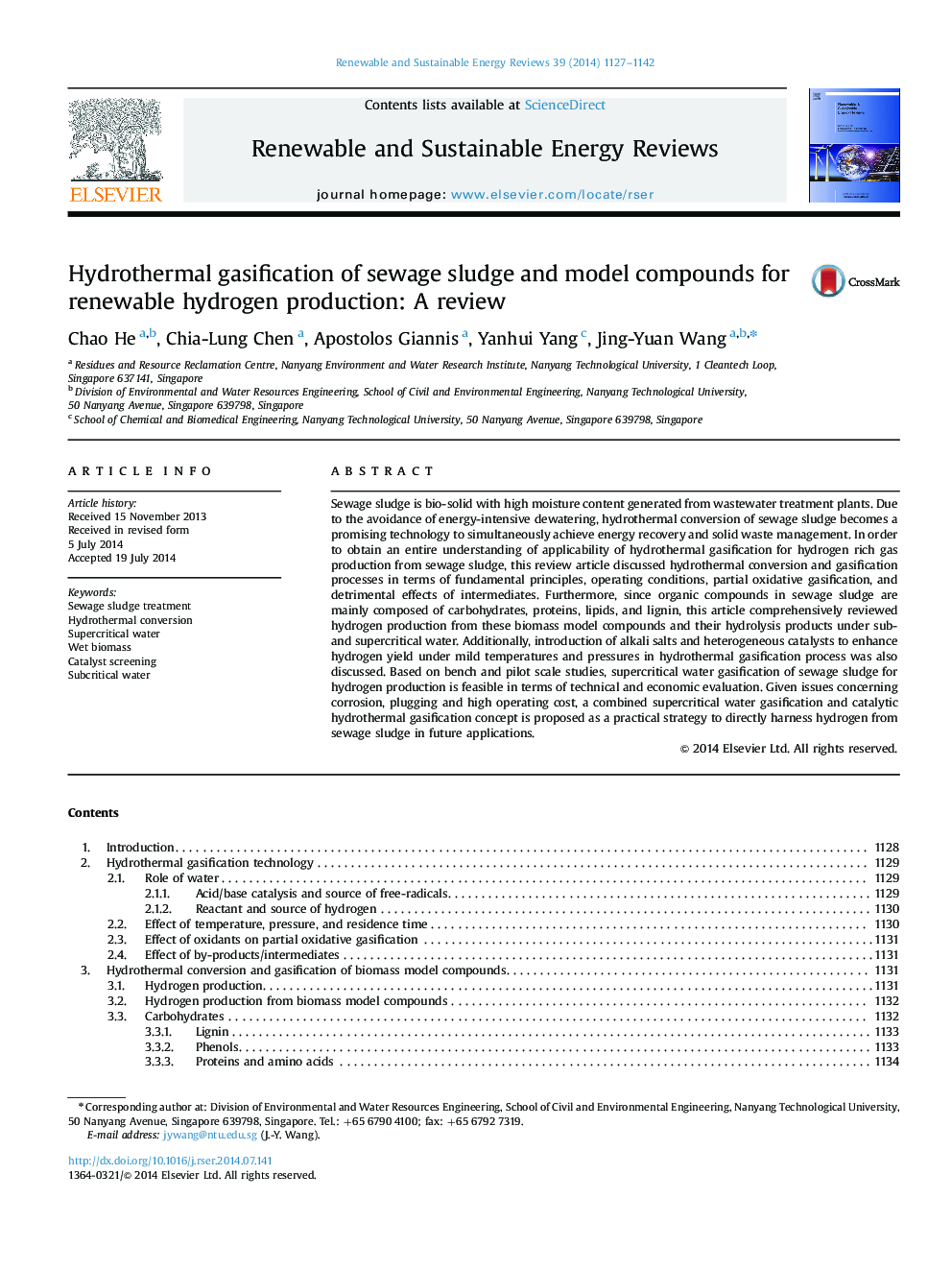| کد مقاله | کد نشریه | سال انتشار | مقاله انگلیسی | نسخه تمام متن |
|---|---|---|---|---|
| 8119323 | 1522346 | 2014 | 16 صفحه PDF | دانلود رایگان |
عنوان انگلیسی مقاله ISI
Hydrothermal gasification of sewage sludge and model compounds for renewable hydrogen production: A review
ترجمه فارسی عنوان
گازسیون هیدروترمال لجن فاضلاب و ترکیبات مدل برای تولید هیدروژن تجدید پذیر: یک بررسی
دانلود مقاله + سفارش ترجمه
دانلود مقاله ISI انگلیسی
رایگان برای ایرانیان
کلمات کلیدی
درمان لجن فاضلاب، تبدیل هیدروترمال، آب فوق بحرانی، زیست توده مرطوب غربالگری کاتالیست آب زیرکریتی،
ترجمه چکیده
لجن فاضلاب بیولوژیکی با رطوبت بالا تولید شده از گیاهان تصفیه فاضلاب است. با توجه به اجتناب از آبیاری شدید انرژی، تبدیل هیدروترمال لجن فاضلاب به یک تکنولوژی امیدوار کننده تبدیل می شود تا به طور همزمان برای بازیافت انرژی و مدیریت زباله های جامد به دست آید. برای به دست آوردن یک درک کامل از کاربرد گازسیون هیدروترمال برای تولید گاز هیدروژن غنی از لجن فاضلاب، این مقاله بررسی روند فرآیند تبدیل و گازسیون هیدروترمال را از نظر اصول بنیادی، شرایط عملیاتی، گازیت اکسیداتیو جزئی و اثرات مضر میان واسطه ها مورد بررسی قرار می دهد. علاوه بر این، از آنجا که ترکیبات آلی در لجن فاضلاب عمدتا از کربوهیدرات ها، پروتئین ها، چربی ها و لیگنین تشکیل شده است، در این مقاله به طور جامد تولید هیدروژن از ترکیبات مدل های زیست توده و محصولات هیدرولیز آنها تحت آب زیر و فوق بحرانی بررسی شده است. علاوه بر این، معرفی نمکهای قلیایی و کاتالیزورهای ناهمگن برای افزایش هیدروژن در دمای پایین و فشار در فرآیند گازسیون هیدروترمال نیز مورد بحث قرار گرفت. بر اساس مطالعات مقدماتی و آزمایشی، گازسیون فوق بحرانی گاز لجن فاضلاب برای تولید هیدروژن از نظر ارزیابی فنی و اقتصادی امکان پذیر است. با توجه به مسائل مربوط به خوردگی، پلاگین و هزینه های بالای عملیاتی، مفهوم گازسیون ترکیبی فوق بحرانی و گازسیون کاتالیزور هیدروترمال، به عنوان یک استراتژی عملی جهت هیدروژن مستقیم از لجن فاضلاب در برنامه های آینده ارائه شده است.
موضوعات مرتبط
مهندسی و علوم پایه
مهندسی انرژی
انرژی های تجدید پذیر، توسعه پایدار و محیط زیست
چکیده انگلیسی
Sewage sludge is bio-solid with high moisture content generated from wastewater treatment plants. Due to the avoidance of energy-intensive dewatering, hydrothermal conversion of sewage sludge becomes a promising technology to simultaneously achieve energy recovery and solid waste management. In order to obtain an entire understanding of applicability of hydrothermal gasification for hydrogen rich gas production from sewage sludge, this review article discussed hydrothermal conversion and gasification processes in terms of fundamental principles, operating conditions, partial oxidative gasification, and detrimental effects of intermediates. Furthermore, since organic compounds in sewage sludge are mainly composed of carbohydrates, proteins, lipids, and lignin, this article comprehensively reviewed hydrogen production from these biomass model compounds and their hydrolysis products under sub- and supercritical water. Additionally, introduction of alkali salts and heterogeneous catalysts to enhance hydrogen yield under mild temperatures and pressures in hydrothermal gasification process was also discussed. Based on bench and pilot scale studies, supercritical water gasification of sewage sludge for hydrogen production is feasible in terms of technical and economic evaluation. Given issues concerning corrosion, plugging and high operating cost, a combined supercritical water gasification and catalytic hydrothermal gasification concept is proposed as a practical strategy to directly harness hydrogen from sewage sludge in future applications.
ناشر
Database: Elsevier - ScienceDirect (ساینس دایرکت)
Journal: Renewable and Sustainable Energy Reviews - Volume 39, November 2014, Pages 1127-1142
Journal: Renewable and Sustainable Energy Reviews - Volume 39, November 2014, Pages 1127-1142
نویسندگان
Chao He, Chia-Lung Chen, Apostolos Giannis, Yanhui Yang, Jing-Yuan Wang,
